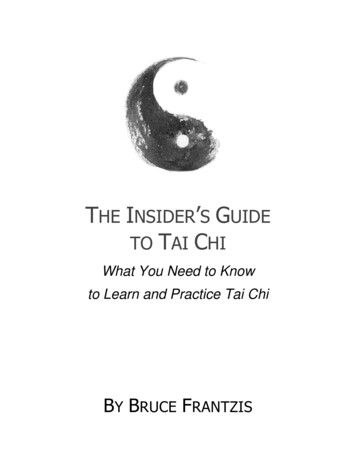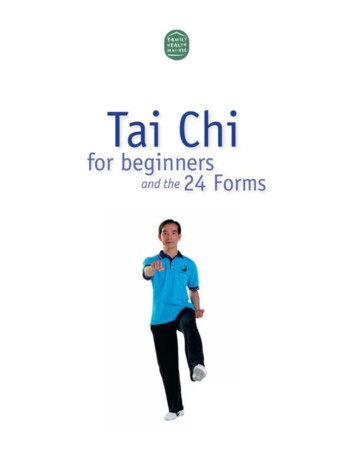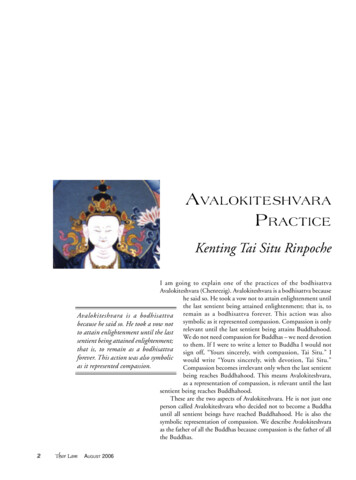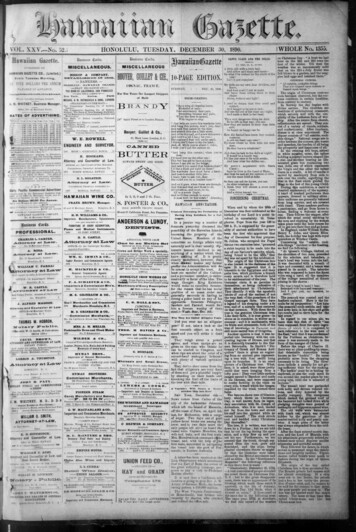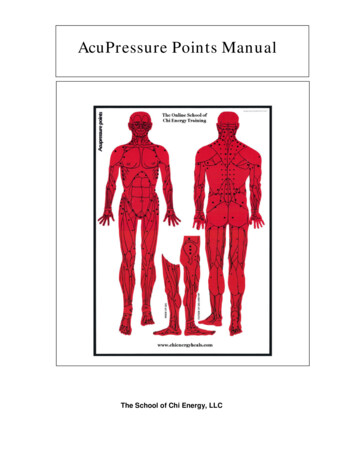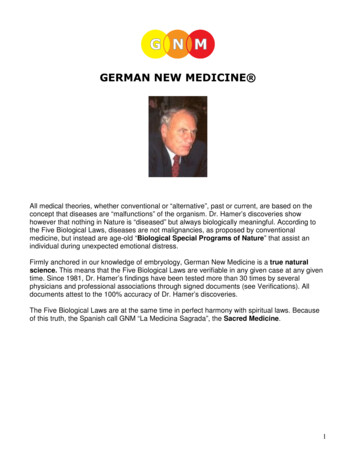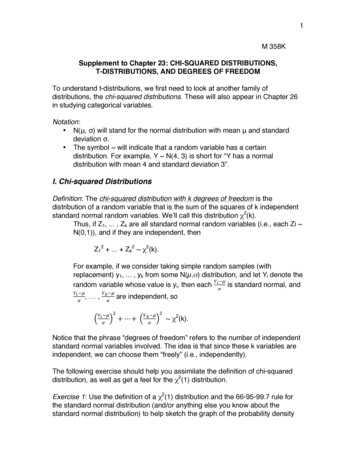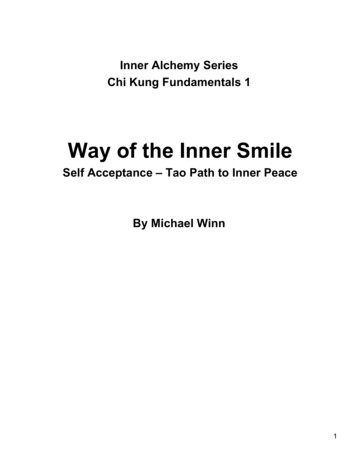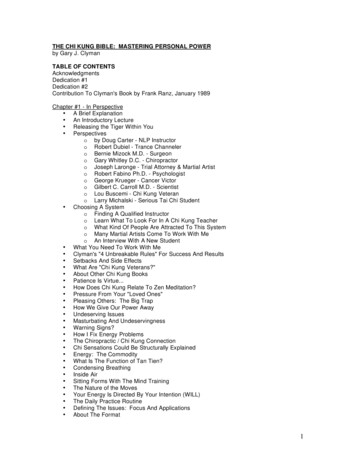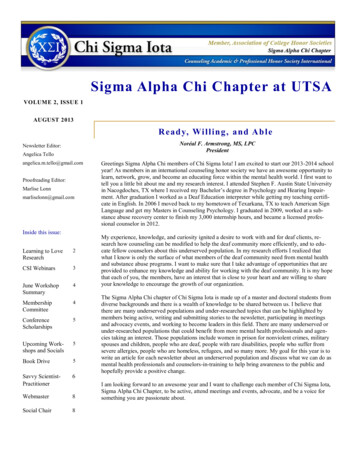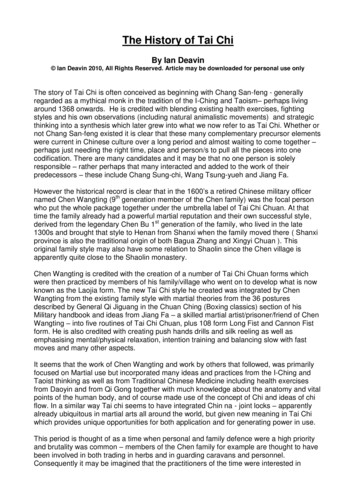
Transcription
The History of Tai ChiBy Ian Deavin Ian Deavin 2010, All Rights Reserved. Article may be downloaded for personal use onlyThe story of Tai Chi is often conceived as beginning with Chang San-feng - generallyregarded as a mythical monk in the tradition of the I-Ching and Taoism– perhaps livingaround 1368 onwards. He is credited with blending existing health exercises, fightingstyles and his own observations (including natural animalistic movements) and strategicthinking into a synthesis which later grew into what we now refer to as Tai Chi. Whether ornot Chang San-feng existed it is clear that these many complementary precursor elementswere current in Chinese culture over a long period and almost waiting to come together –perhaps just needing the right time, place and person/s to pull all the pieces into onecodification. There are many candidates and it may be that no one person is solelyresponsible – rather perhaps that many interacted and added to the work of theirpredecessors – these include Chang Sung-chi, Wang Tsung-yueh and Jiang Fa.However the historical record is clear that in the 1600’s a retired Chinese military officernamed Chen Wangting (9th generation member of the Chen family) was the focal personwho put the whole package together under the umbrella label of Tai Chi Chuan. At thattime the family already had a powerful martial reputation and their own successful style,derived from the legendary Chen Bu 1st generation of the family, who lived in the late1300s and brought that style to Henan from Shanxi when the family moved there ( Shanxiprovince is also the traditional origin of both Bagua Zhang and Xingyi Chuan ). Thisoriginal family style may also have some relation to Shaolin since the Chen village isapparently quite close to the Shaolin monastery.Chen Wangting is credited with the creation of a number of Tai Chi Chuan forms whichwere then practiced by members of his family/village who went on to develop what is nowknown as the Laojia form. The new Tai Chi style he created was integrated by ChenWangting from the existing family style with martial theories from the 36 posturesdescribed by General Qi Jiguang in the Chuan Ching (Boxing classics) section of hisMilitary handbook and ideas from Jiang Fa – a skilled martial artist/prisoner/friend of ChenWangting – into five routines of Tai Chi Chuan, plus 108 form Long Fist and Cannon Fistform. He is also credited with creating push hands drills and silk reeling as well asemphasising mental/physical relaxation, intention training and balancing slow with fastmoves and many other aspects.It seems that the work of Chen Wangting and work by others that followed, was primarilyfocused on Martial use but incorporated many ideas and practices from the I-Ching andTaoist thinking as well as from Traditional Chinese Medicine including health exercisesfrom Daoyin and from Qi Gong together with much knowledge about the anatomy and vitalpoints of the human body, and of course made use of the concept of Chi and ideas of chiflow. In a similar way Tai chi seems to have integrated Chin na - joint locks – apparentlyalready ubiquitous in martial arts all around the world, but given new meaning in Tai Chiwhich provides unique opportunities for both application and for generating power in use.This period is thought of as a time when personal and family defence were a high priorityand brutality was common – members of the Chen family for example are thought to havebeen involved in both trading in herbs and in guarding caravans and personnel.Consequently it may be imagined that the practitioners of the time were interested in
dealing with brutality as efficiently as possible – and taking Chen Wangting as an example,were already capable fighters looking for a better way of dealing with aggression. Inaddition it seems also likely that many of the experienced fighters would be looking tocontinue their abilities into older age and perhaps able to work from a perspective ofexperience in Traditional Chinese Medicine. Thus giving rise to the twin faces of Tai Chiand Tai Chi Chuan – health and martial application. Equally the Taoist lineage broughtwith it an intellectual approach to observing and thinking about the world both practicallyand philosophically, thus enabling a thoughtful way of approaching the development of amartial art.This martial/health dichotomy is exemplified by the story of Yang style derived from YangLuchan who is said to have learned Chen style covertly while living in the village in theearly 1800’s – but to have been accepted as a student when he demonstrated his abilityagainst various family members.Yang Luchan was the first outsider to learn the original form of what we now know asLaojia when he was taught by Chen Changxing. He left the Chen village after many yearspractice and travelled around China taking on all comers and was unbeaten – thus earningthe title Yang the Invincible – a very martial beginning for the family style. He eventuallywent to Beijing as tutor to the Emperor’s guard and taught his Tai Chi Chuan to his family.It seems that his form diverged as it passed from him through his descendents, becomingfocused on the health benefits via his grandson Yang Chen Fu –who wished to spread thebenefits of Tai Chi more widely in order to improve the health of the nation - this is thestyle most popularly known today.I have trained with Mai Lee Yang (the granddaughter of Yang Chen Fu) in Hong Kong andshe still viewed Tai Chi practice as a martial art – indeed the form still retains manyaspects that are of martial value and it may be that Yang Chen Fu himself and possiblysome close students continued to practice a more martial version of the form. Indeed itwas my own experience that it greatly added to the effectiveness and application of theKarate which I also practiced at the time. However it seems widely accepted that mostYang style today is practiced primarily for health and it is clear that in the west at least TaiChi is seen in the mainstream culture as almost entirely health related. So from YangLuchan to modern day global Yang style (until recent years “The” global Tai Chi style) wehave seen a complete conversion in the space of around 200 years.There have been many Yang style spin-offs over time – one well known being that of ChenMan Ching who initially trained under Yang Chen Fu and then went to the USA where hisform has become very popular for it’s softness.While this spreading and diverging of Yang Style Tai Chi was going on around the Beijingfocus the original Chen style was itself undergoing change, notably by Chen Changxing14th generation and teacher of Yang Luchan, who is also credited with codifying the “oldframe” Laojia form. At the same time Chen Youben, also 14 th generation is credited withdevising a new small frame form called Xiao-jia. This was followed by 16th generationmember Chen Xin who wrote the first book on Chen Style “Illustrated Explanations ofChen Family Taijiquan” based around the Xiao-jia form, although not published until 1932.From a personal perspective it is clear from even a cursory look through this book that TaiChi was being studied in a huge depth of detail and confirms the constant references backto the I-Ching also to Taoist ideas of how the world works as well as the theory of Chiwhich were clearly fundamental in developing the intellectual model that has driven thephysical style.
Then at around the same time as Yang Chen Fu – in the period of the late 1800s/early1900s Chen Fake 17th generation also went from the Chen village to Beijing as aninstructor where he acquired a significant reputation as a fighter and developed what isnow known as the Chen Xinjia form.Stemming from this there are many other family derivatives of the Chen and Yang mixincluding Wu style, Wu (Hao) style and Sun style – these are generally considered the big5 and are all traceable through relatively few practitioners who often knew or were relatedand trained with each other or with a connected lineage bearer.Wu style derives from Quan You a leading student of Yang Luchan and his son Yang PanHou – the Wu family style originating from Quan You’s son Wu Jianquan.(Old) Wu (Hao) style derives from Wu Yu Xiang (1812-1880) who also studied with YangLuchan for many years and then in the Chen village for 3 months under Chen Ching-ping.His family style was derived from this experience and is often referred to as Hao style afterthe Hao Wei Zhen – the second generation successor. The first generation successor Li Iyu also went on to form his own style now differentiated as Li style.Hao Wei Zhen went on to meet and pass on his Tai Chi to Sun Lu-tang – an experiencedpractitioner of Xingyi and many other martial styles. Sun Lu Tang was known as aproficient fighter who went on to produce his own Sun style of Tai Chi.I learned Sun style from Sun Lu Tang’s daughter Sun Jian Yun at the Beijing People’sUniversity. She described her father in strong terms and the form as primarily martial inintent. I was impressed by the compactness and obvious short range application of Sunstyle. Discussion with one of Madam Sun’s students also revealed a knowledge ofacupuncture/vital points along with Tai Chi.The core of Tai Chi is therefore quite interlinked – nurtured for 200 years by thepractitioners of the Chen village and then in the past 200 years going from Chen to Yangto Wu and Hao to Sun - all now growing in parallel and still splitting off yet more variants.The University in Beijing under Professor Li Deyin is much involved in what has developedas a sport side to Tai Chi with many competitions taking place both nationally andinternationally around the world. These include forms, sparing and push hands. Sportforms of Tai Chi are judged on visual technique and on rule based competitions withexpert judges awarding points for observed skill. The University training is often quite akinto gymnastics/acrobatics with students learning first a number of “hard” Kung Fu stylesand then Xingi, Bagua and Tai Chi. I believe that the background martial understanding isretained at the university and certainly teachers such as Wang Yang Ji who have come outof this system can demonstrate a good level of martial skill.Tai Chi in the parks of China appears to have been incorporated into a social melee ofhealth and leisure activities alongside Qi Gong, religious meetings, stretching, running,ballroom dancing and rock-and-roll. It is often taken up by men and women when theyapproach retiring age or if they have a health problem such as arthritis. Typically thesepractioners spend a couple of hours or more first thing in the morning exercising and intheir 60’s 70’s and 80’s are often delighted to share and demonstrate their skill.It is likely that word of Tai Chi found its way to the west by the transmission of travellerswho visited China from the early 1900s onwards and brought back their understanding –
sadly they were few in number and perhaps limited in their understanding by the short timeit was generally possible for them to stay. They did lay valuable ground work andgenerated visibility such that when I started training in martial arts in 1970 Tai Chi wasknown of in the west and a few books were available. Although good teaching was notwidespread in the UK – primarily only in London. Later I was introduced to Yang style bymy Karate teacher Hirokasu Kanazawa who learned 24 step Yang style in Japan from aChinese teacher in exchange for Karate instruction.The world wide spread of Tai Chi was promoted in parallel by the emigration of teachersfrom China after the communist revolution, again in the period after the 2nd World War andlater after the Cultural Revolution. These teachers gave the rest of the world its first tasteof genuine home-grown Chinese internal martial arts. They have more recently includedthose now encouraged by the Chinese government to visit the west for promotion ofChinese martial arts and culture in general.Emigrant teachers include people like Chu King-hung who came to London from HongKong to teach Yang style in the Yang Chen Fu tradition and Chen Xiaowang 19thgeneration head of the Chen family who now travels around the world as ambassador forChen style.In recent years Tai Chi focused organisations have successfully promoted the sport side ofTai Chi both inside China and worldwide, such that competitive forms and sparing of manysorts are now highly visible and give a counterpoint to the health/meditation aspects seenwidely in popular media.Consequently Tai Chi of many variations is now hugely popular all around the world andeach tradition continues to grow and “spin-off” new shoots. In recent years perhaps themost significant development however has been the dramatic growth of the oldest style ofall – Chen style - resulting from the efforts of Chen Xiaowang (grandson of Chen Fake17th generation) and the three others of the quartet referred to as the “Four BuddhaWarrior Attendants” from the Chen village i.e. Chen Zhenglei, Wang Xian and Zhu Tiancai.Having so long nurtured the traditional martial root of Tai Chi Chuan these Chen villageteachers are giving us the opportunity to return to that root and fully appreciate the value ofa style that being true to its core values still contains a full and balanced martial synthesis.These travellers and emigrant teachers have seeded the establishment of a “Tai Chiculture” in the west. This has now developed it’s own highly skilled teachers such as Kareland Eva Koskuba – who having met and trained under Chinese teachers in the UK orelsewhere, then sought to further their training in China itself – thus developing thematurity of Tai Chi outside China.In the UK at least, Tai Chi now has quite a high profile as a “brand”, especially within thealternative health and leisure market, where it has gained increasing popularity as a“wrapper” for stress reduction/health/mobility exercise classes. Consequently we see arepetition of the established Martial/Health/Sport balance seen elsewhere in martial artsaround the world. This blossoming of the martial art of Tai Chi, which once encompassedall these facets in one discipline, is now becoming fragmented into many different aspectseach with its own adherents, lineage and history – a reflection of the globalisation processseen elsewhere.On reflection we can see the history of Tai Chi as a historical “way” or “path” ofdevelopment over time in the association of ideas derived from the early natural sciences
and philosophical thinking with health/medical practices, coming together with the practicalfighting styles – a cross linking perhaps fuelled by the needs of injured warriors to repairand of healthy ones to strengthen their bodies and to enhance their abilities. Thesepractical ideas synthesised by a relatively few individuals, over quite a short period of time,went beyond the straightforward external fighting styles into something more complex andsophisticated – perhaps because many martial people were/are also intelligent thinkers.Also, perhaps because we can observe a historically common path from warrior to healer,the fighting style and the contributing health/philosophical etc practices continue to beintimately intertwined, indeed it is sometimes difficult to differentiate between them. Thispath has continuously developed a powerful fighting art over some 400 years and 19generations with each transmission through another mind/body adding or subtracting alittle at each stage. However the 20th century process of globalisation has also seenpractitioners move away from its martial origin to pursue Tai Chi for other objectives and ina sense we have come full circle – where once the art brought other disciplines togethernow it is being used to propagate them.So what of the future for Tai Chi? – with the energetic activities of Chen Xiaowang, his coteachers from the Chen village and direct lineage students around the world, it is to behoped that we will be able to retain a true transmission of the traditional art whatever otherdevelopments and blending of cultures takes place.- ends Appendices:- The role of other internal arts in understanding the history and development of TaiChi.- Diagram of the Family lineage of Tai Chi- List of sourcesThe role of other Internal arts in understanding the history and development of TaiChi – the co-linear developments of Xingyi, Bagua and YiquanIn understanding the history and development of Tai Chi it is useful to look at the parallelpaths of the other internal arts of Xingyi, Bagua and Yiquan. In the case of Xingyi it has itsroots in the early 1100s with the historical figure of General Yue Fei (1103-1142) althoughit is said that the earliest reliable evidence refers to Ji Long Feng (early 1600s) of Shanxiprovince (origin of the Chen family) who used his expertise with the spear to develop“Heart Mind Six Harmonies” boxing for protection in times of peace. This concept utilisesthe linkage between mind and body to develop a style beyond what is possible with bodyalone – this is analogous to the intention training with which Chen Wanting is credited.Indeed Xing Yi Quan is translated as “form-intent boxing” alternately “mind-body boxing”and was originally called “Heart Mind Six Harmonies Boxing”. Like Chen Wangting, Ji LongFeng also lived in the early 1600s and his style shares some ideas, such as the sixharmonies and chi concepts and clearly came out of the same social/philosophical milieu,but followed a structure based much more on animalistic characteristics and traditionalmartial ideas around the expression of power. Xingyi too has gone through lineagediversification of styles as it has spread geographically although it is probably true to saythat like the style itself it has been more linear in adhering to a strictly martial tradition.
Baguazhang on the other hand is traced back to Dong Hai Chuan living in the mid-1800s(contemporary with Chen Changxing and Yang Luchan) whose ancestral lineage is alsotraceable to Shanxi province – although he is said to have learned his style from a Taoistmonk called Dong Meng-Lin. The Taoist input is most obviously noticeable in the circlewalking based on the meditation practice of the Taoist Quan Zhen sect, which ischaracteristic of Baguazhang and the use of the 8 Trigram Bagua from the I-Ching as anintellectual structural concept for the style – thus defining the mental intent ( mantra) of thetraining. Bagua too has experienced a geographical spread but like Xingyi seems to haveattracted primarily the martially inclined.Yiquan – the forth and most recent internal style comes out of the Xing Yi Quan lineagefrom its creator Wang Xiangzhai (1890-1963) who trained in Xing Yi Quan and spent manyyears researching martial arts. This led him to simplify the training process by removingwhat he considered as the unnecessary physical forms and to focus much more on themental training, coupled with simple Qigong like exercises. He therefore dropped the “xing”(form) from the name Xing Yi Quan and called his system Yi Quan, where Yi refers to Mindor Intent. This perhaps best exemplifies just how far the development of internal arts cango and does appear to be the one defining factor of these arts – the use of the mind intraining to develop bodily power and skill.
Family lineage of Tai Chi
Sources:Chen Family Tai Chi Classics – Waysun LiaoYang Family Secret Transmissions – Douglas WileTai Chi for Every Body - Karel & Eva KoskubaThe Illustrated Canon of Chen Family Taijiquan - Chen /wiki/chen style tai chi p://www.embracethemoon.com/master Walk.php?page m/icom historyhttp://www.deyin-taiji.com/professor li taichi.orgwww.taichiblog.org
described by General Qi Jiguang in the Chuan Ching (Boxing classics) section of his Military handbook and ideas from Jiang Fa – a skilled martial artist/prisoner/friend of Chen Wangting – into five routines of Tai
